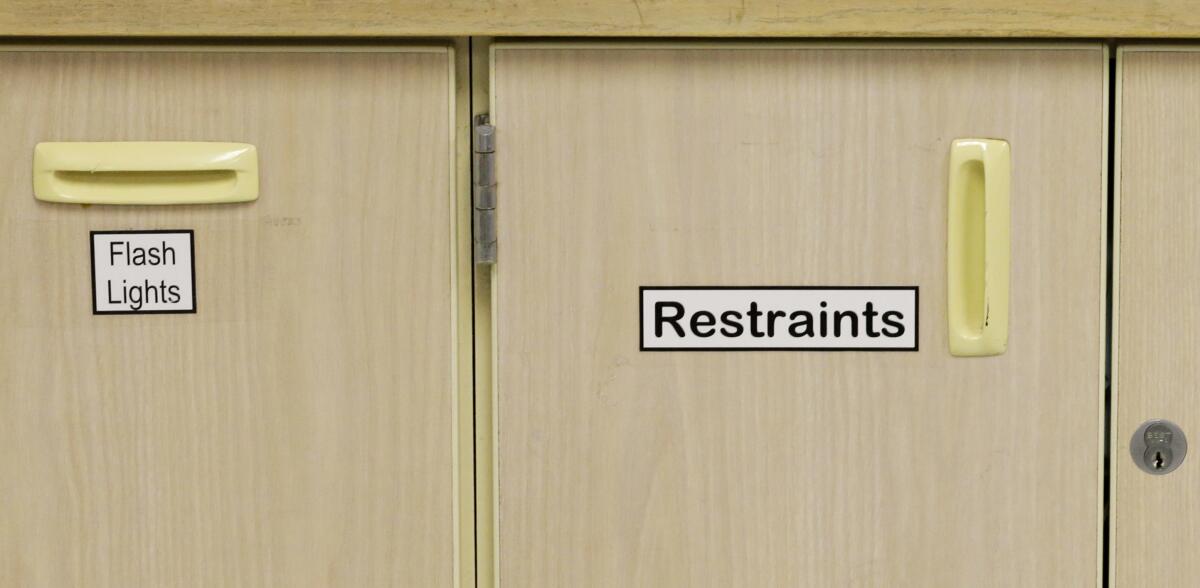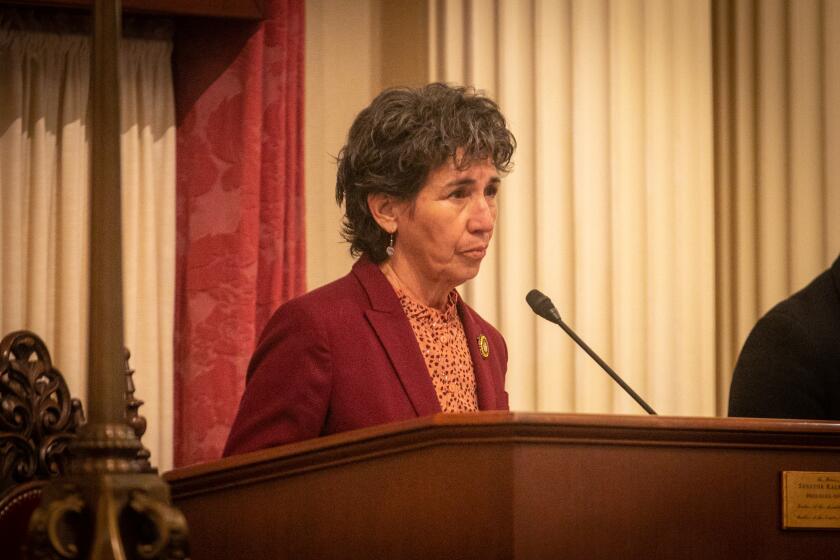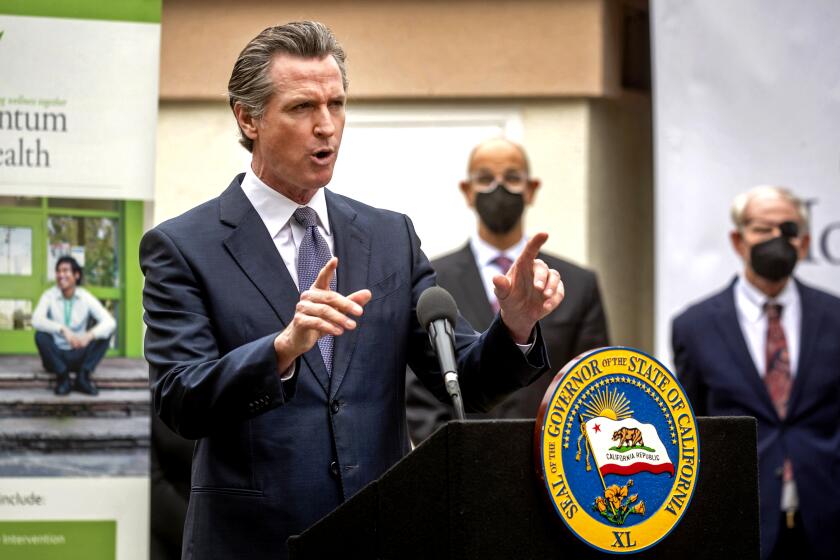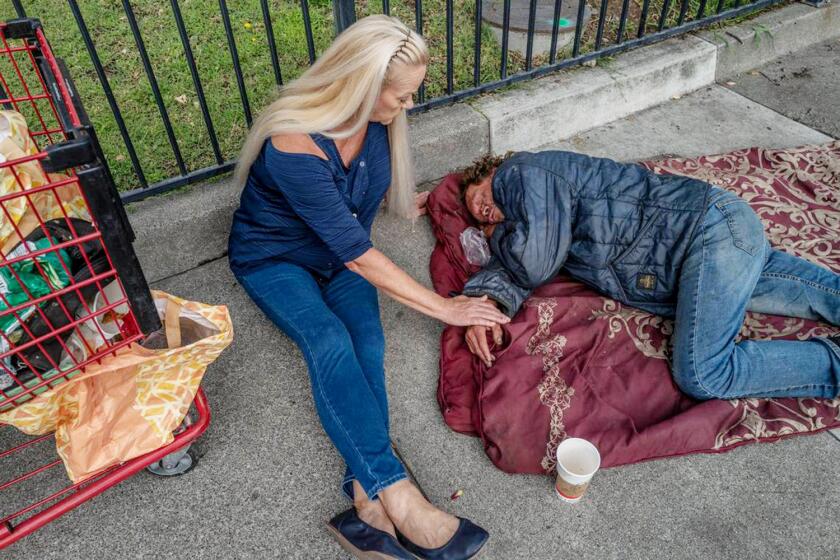California wants more psychiatric detentions. That’s unlikely to improve anyone’s mental health

- Share via
Another mental health bill is before the California Senate, passed by the judiciary committee on April 25. This bill, backed by some urban mayors, would make it easier to forcibly treat more people. It comes on the heels of CARE Court, a program rolling out this year that broadened state powers to impose psychiatric care.
Promoters of forced treatment often push a well-known tale: Since the 1950s, many state hospital asylums have closed, and strict, rights-protecting mental health laws emerged. Today, the story goes, practically no one gets compelled into psychiatric care even if they’re extremely dangerous. As a result, streets overflow with mentally ill people.
That narrative makes it seem reasonable to broaden laws to forcibly treat more people for mental disorders as a way to reduce homelessness. But this story disguises the fact that rates of detentions and forced treatment have been rising in the U.S. for decades without achieving measurable improvements on mental health or homelessness.
The latest effort to overhaul the LPS Act — California’s landmark mental health legislation — arrives with renewed momentum from Gov. Gavin Newsom’s initiatives. Will SB 43 succeed?
From the 1960s to ’80s, as most asylums closed, the Supreme Court and other federal courts attempted to establish tighter restrictions on forcibly treating people under civil mental health laws. But many states never followed suit, or they passed laws to re-broaden the criteria enabling detentions.
California passed its Lanterman-Petris-Short Act in 1967 to establish danger to self or others or grave disability as criteria justifying involuntary psychiatric interventions — terms that in practice can be interpreted flexibly. In a 2019 review, the State Auditor found no need to expand the Lanterman-Petris-Short criteria to help Californians. Yet there have been repeated efforts to do just that, sometimes to shocking degrees — under California’s latest bill, a person would be a potential candidate for forced treatment if they’re not “adequately clothed” or not performing necessary “personal” care.
In addition to objecting to existing laws, some pro-force advocates argue that asylum closures created a shortage of beds for detentions. But a 2017 study found that, since 1970, beds in places such as general hospital psychiatric wards, private psychiatric hospitals and residential treatment centers have doubled or tripled. Though their numbers are less well-tracked, there has also been massive growth in long-term care facilities, supportive housing and group homes that have psychiatric beds and often require treatment compliance for residents to stay there. Studies that followed asylum patients found that most were transitioned into these latter institutions (not left homeless or imprisoned). Today, these act as the “new asylums” for people labeled with serious mental illnesses.
State tracking of psychiatric detentions is incomplete and inconsistent. But the data indicate that involuntary commitments have risen around the country for many years. In a landmark 2020 study, UCLA social welfare researchers David Cohen and Gi Lee examined civil psychiatric detentions in the U.S. since 2010. Examining the trends across 22 states with sufficient available data, Cohen and Lee found that, overall, per-capita detentions increased at three times the population growth. The U.S. has an estimated 1.2 million forced detentions a year under civil mental health laws, a rate of 357 per 100,000 people — double, triple or many more times the rates documented in the U.K. and comparable Western European countries.
Los Angeles County is poised to join the first wave of counties to launch a sweeping new mental health plan pushed by Gov. Gavin Newsom.
Studies show that California detains people at a rate even higher than the U.S. average. Consider the state’s three-day detentions, known as 5150 holds (which can lead to longer-term detentions). In 2021, the state imposed more than 120,000 such detentions on adults and 21,000 on children. That year, Los Angeles County had 54,291 of these detentions overall. New York University sociologist Alex Barnard, author of a book about California’s coercive practices, says the numbers are likely higher, pointing to San Francisco as a case study. In 2021, the county reported 1,487 such detentions, but an evaluation of health institutions estimated the number to be about nine times higher: 13,065.
As psychiatric detentions increase, and officials clamor for more, it’s not at all clear that they help people more than they harm. Some people have painful anecdotes about family members whom they wanted to compel into treatment before their problems worsened. But as summarized by a 2019 review of scientific literature on coercive care: “there is little evidence [coercive interventions] confer any clinical benefits,” making it “paradoxical” that these interventions “continue to be used extensively.” Worse, the authors wrote, forced interventions are “often associated with negative outcomes” and experienced as “highly distressing and even traumatic.”
It’s not difficult to understand why. While some detentions evolve into a collaborative process between patient and doctor, forced treatment is often brutal, involving threats, security guards, stripping, restraints and heavy tranquilization. For some people, forced sedation and severe adverse drug effects — such as diabetes and movement disorders — can continue torturously for years under Assisted Outpatient Treatment or conservatorships. There are many people who want help but choose homelessness over such “care,” which is why many researchers advocate for noncoercive, supportive housing.
CARE Court, California’s plan for helping those with severe mental illness, is under attack by civil rights groups. But families fighting to help their loved ones say compassion demands intervention.
This reality runs counter to the argument — a popular one in California, given the state’s housing crisis — that involuntary treatment will help unhoused people with mental health issues get off the street. Homelessness began worsening after deep cuts to affordable housing, and homelessness itself can cause and exacerbate mental disorders and addiction. Unhoused people need homes, not forced treatment.
Nevertheless, unhoused people are aggressively policed as part of a bigger trend toward using mental health laws as tools for social control. People call 911 to report the unhoused — and also their own relatives during family conflicts. During the research for my book, I found that involuntary psychiatric interventions get widely imposed, including on unruly schoolchildren, distressed seniors, disability benefits recipients, workplace whistleblowers, callers to mental health helplines and pregnant women.
Truly caring public health responses — and ones in line with the data and evidence — would mean reducing or eliminating, not expanding, coercive mental health interventions.
Rob Wipond is an investigative journalist and author of “Your Consent Is Not Required: The Rise in Psychiatric Detentions, Forced Treatment, and Abusive Guardianships.”
More to Read
A cure for the common opinion
Get thought-provoking perspectives with our weekly newsletter.
You may occasionally receive promotional content from the Los Angeles Times.












